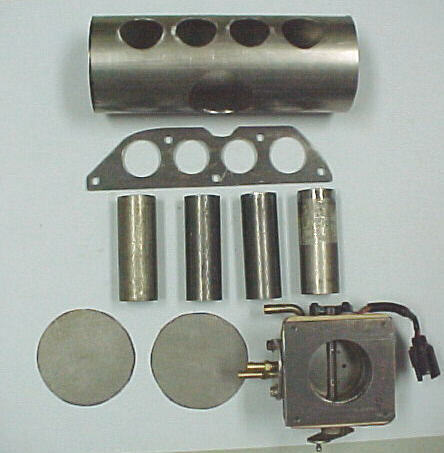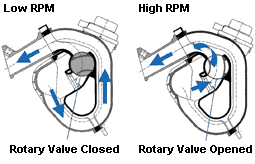Alot of people have been asking about intake manifolds and alot of incorrect information has been passed around so i figured i start a thread and help clear some up. Feel free to agree/disagree.
As everyone knows a good start in building an engine up is to put an intake on it. An intake allows more air to reach the engine. It also allows air to travel quicker and smoother then an air box (which is why the tube has no real bends and is the same diamater all the way to the throttle body).
From there it reaches the throttle body. Depending on the size of the throttle body depends on how quickly the air is moved into the intake manifold (then to the chambers). A larger throttle body will allow a better throttle response (less time to fill up the plenum of the intake manifold. Much like filling a water balloon from a hose, the larger the end of the hose the quicker the balloon fills.)
As the intake manifold goes there a few things to increase and watch for. One is the size of the plenum. The plenum is much like a water gun tank (remeber the yellow round bottle that was on the guns that you filled with water, same thing only this gun has four holes that shoot water). The plenum fills with air.
Now skip the runners for a second, and you have the cam, valves, and chambers (cylinders). When a full revoloution occurs the last stroke is the exhaust stroke. This means there is nothing left inside the chamber (cylinder). This creates a vacum (a very strong vacum). The air thats in the plenum is then pushed into the chamber due to this vacum. (air doesn't techincly fill up and wait since at every moment a cylinder requires air)
Air then travels through the runners of the intake manifold. This is much like a hose, Creating velocity will get the air to the chambers quicker. Also with some true physics involved when it hits the chamber it pushs against a wall (as if you ran into a wall you would be flat against it). This allows some compression even before the pistons become involved.
The different kinds of intake manifolds:
Stock Manifolds: Generally very restrictive and long runners. The plenum is generally not very round (causeing the air to bounce off in unpridictable manners) and have a small capcity. The runners and plenum aren't very smooth at all (again causing irregularities in the air flow).
Aftermarket N/A Manifolds: Much like a port and polish job the Plenum has a larger capacity and and is much smoother. They also look much like the d16y8 manifolds where the plenum is round (like the water gun tank). The runners a generally a little shorter and much more open.
Aftermarket Turbo Manifolds: When it comes to turbo all that matters is the flow (the rythem or wave motion). Its also about getting the air to the chambers as quickly as possible. Shorter runners are used for this. The shorter runners and even larger plenum are alot less effective at lower rpms (from idel to 5,000) due to the fact that the velocity is down.
The Hose Analogy: Imagine a hose with water running through it to fill a jug, someone is constantly turning the water from low running to full.
A Stock manifold is a hose that has to small of a diameter for the water to be pushed out effectivly. It works great at lower pressure but as it increases it becomes to restricted. If you were to add even more pressure it would brake the hose. (as in adding a turbo.)
A N/A Manifold would be just adding a bigger diamter hose. It works at all water pressure (not as well at low but still works fine and works even better then stock from mid to high)
A turbo is the largest diamater hose you can get. However, if the water is not on all the way it has no velocity. (works effective at high only).
As everyone knows a good start in building an engine up is to put an intake on it. An intake allows more air to reach the engine. It also allows air to travel quicker and smoother then an air box (which is why the tube has no real bends and is the same diamater all the way to the throttle body).
From there it reaches the throttle body. Depending on the size of the throttle body depends on how quickly the air is moved into the intake manifold (then to the chambers). A larger throttle body will allow a better throttle response (less time to fill up the plenum of the intake manifold. Much like filling a water balloon from a hose, the larger the end of the hose the quicker the balloon fills.)
As the intake manifold goes there a few things to increase and watch for. One is the size of the plenum. The plenum is much like a water gun tank (remeber the yellow round bottle that was on the guns that you filled with water, same thing only this gun has four holes that shoot water). The plenum fills with air.
Now skip the runners for a second, and you have the cam, valves, and chambers (cylinders). When a full revoloution occurs the last stroke is the exhaust stroke. This means there is nothing left inside the chamber (cylinder). This creates a vacum (a very strong vacum). The air thats in the plenum is then pushed into the chamber due to this vacum. (air doesn't techincly fill up and wait since at every moment a cylinder requires air)
Air then travels through the runners of the intake manifold. This is much like a hose, Creating velocity will get the air to the chambers quicker. Also with some true physics involved when it hits the chamber it pushs against a wall (as if you ran into a wall you would be flat against it). This allows some compression even before the pistons become involved.
The different kinds of intake manifolds:
Stock Manifolds: Generally very restrictive and long runners. The plenum is generally not very round (causeing the air to bounce off in unpridictable manners) and have a small capcity. The runners and plenum aren't very smooth at all (again causing irregularities in the air flow).
Aftermarket N/A Manifolds: Much like a port and polish job the Plenum has a larger capacity and and is much smoother. They also look much like the d16y8 manifolds where the plenum is round (like the water gun tank). The runners a generally a little shorter and much more open.
Aftermarket Turbo Manifolds: When it comes to turbo all that matters is the flow (the rythem or wave motion). Its also about getting the air to the chambers as quickly as possible. Shorter runners are used for this. The shorter runners and even larger plenum are alot less effective at lower rpms (from idel to 5,000) due to the fact that the velocity is down.
The Hose Analogy: Imagine a hose with water running through it to fill a jug, someone is constantly turning the water from low running to full.
A Stock manifold is a hose that has to small of a diameter for the water to be pushed out effectivly. It works great at lower pressure but as it increases it becomes to restricted. If you were to add even more pressure it would brake the hose. (as in adding a turbo.)
A N/A Manifold would be just adding a bigger diamter hose. It works at all water pressure (not as well at low but still works fine and works even better then stock from mid to high)
A turbo is the largest diamater hose you can get. However, if the water is not on all the way it has no velocity. (works effective at high only).









